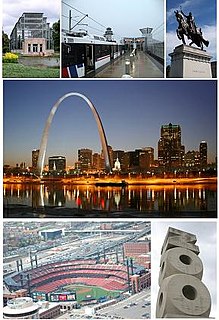
St. Louis is a major independent city and inland port in the U.S. state of Missouri. It is situated along the western bank of the Mississippi River, which marks Missouri's border with Illinois. The Missouri River merges with the Mississippi River just north of the city. These two rivers combined form the fourth longest river system in the world. The city had an estimated 2017 population of 308,626 and is the cultural and economic center of the St. Louis metropolitan area, which is the largest metropolitan area in Missouri, the second-largest in Illinois, and the 20th-largest in the United States.

William Cuthbert Faulkner was an American writer and Nobel Prize laureate from Oxford, Mississippi. Faulkner wrote novels, short stories, screenplays, poetry, essays, and a play. He is primarily known for his novels and short stories set in the fictional Yoknapatawpha County, based on Lafayette County, Mississippi, where he spent most of his life.

Shelby County is a county in the U.S. state of Tennessee. As of the 2010 census, the population was 927,644. It is the state's largest county both in terms of population and geographic area. Its county seat is Memphis, a port on the Mississippi River and the second most populous city in Tennessee. The county was named for Governor Isaac Shelby (1750–1826) of Kentucky.

LaFayette is the county seat of Chambers County, Alabama, United States, 47 miles (76 km) northwest of Columbus, Georgia. As of the 2010 census, the population of the city was 3,003.
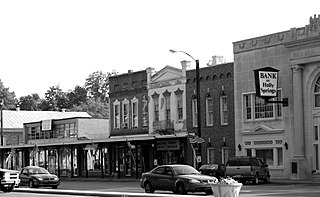
Holly Springs is a city in and county seat of Marshall County, Mississippi, United States at the border with southern Tennessee. Near the Mississippi Delta, the area was developed by European Americans for cotton plantations and was dependent on enslaved Africans. After the American Civil War, many freedmen continued to work in agriculture but as sharecroppers and tenant farmers.
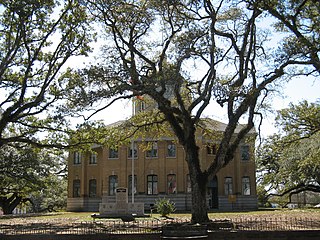
Woodville is a town in and the county seat of Wilkinson County, Mississippi, United States. The population was 1,096 at the 2010 census.

Yoknapatawpha County, pronounced is a fictional Mississippi county created by the American author William Faulkner, based upon and inspired by Lafayette County, Mississippi, and its county seat of Oxford, Mississippi. Faulkner often referred to Yoknapatawpha County as "my apocryphal county".
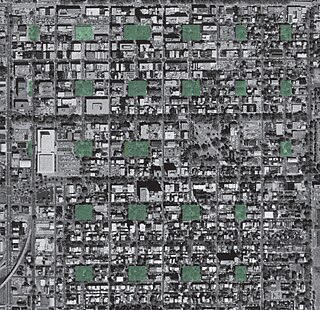
The U.S. city of Savannah, Georgia was laid out in 1733 around four open squares, each surrounded by four residential ("tything") blocks and four civic ("trust") blocks. Once the four wards were developed in the mid-1730s, two additional wards were laid out. The layout of a square and eight surrounding blocks was known as a "ward." The original plan was part of a larger regional plan that included gardens, farms, and "out-lying villages." While some authorities believe that the original plan allowed for growth of the city and thus expansion of the grid, the regional plan suggests otherwise: the ratio of town lots to country lots was in balance and growth of the urban grid would have destroyed that balance.

The Ogle County Courthouse is a National Register of Historic Places listing in the Ogle County, Illinois, county seat of Oregon. The building stands on a public square in the city's downtown commercial district. The current structure was completed in 1891 and was preceded by two other buildings, one of which was destroyed by a group of outlaws. Following the destruction of the courthouse, the county was without a judicial building for a period during the 1840s. The Ogle County Courthouse was designed by Chicago architect George O. Garnsey in the Romanesque Revival style of architecture. The ridged roof is dominated by its wooden cupola which stands out at a distance.

The Downtown Santa Ana Historic Districts is a combination of local historic districts that have been listed as one entry in the National Register of Historic Places since 1984. It is a 24.5-acre (9.9 ha) area. Also known as the Historic Downtown District in Santa Ana, it is roughly bounded by Ross to French streets and First to Civic Center streets. The district is characterized by a number of buildings in the Art Deco style as well as two old movie houses. Orange County's first Courthouse, now a museum, is also located on Civic Center and Broadway streets. The Dr. Willella Howe-Waffle House and Medical Museum is also in this area and it is now home to the Santa Ana Historical Preservation Society. The County's first theater, Walker's Theater, was built in 1909 on Main & Second streets adjacent to the old City Hall. Today, the Main Street Studio Lofts now stand where the county's first movie house used to be.
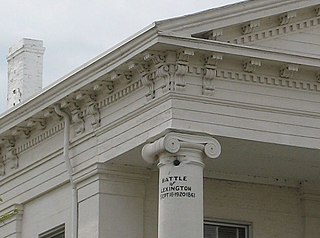
The Lafayette County Courthouse is a historic courthouse located at Lexington, Lafayette County, Missouri. It was built in 1847 and is the oldest courthouse in continuous use west of the Mississippi River. It is known far and wide for the cannonball embedded in the upper left column, a remnant of the Civil War Battle of Lexington I, fought on September 18, 19 and 20, 1861.

Lafayette Square is a park in the center of downtown Buffalo, Erie County, New York, United States that hosts a Civil War monument. The block, which was once square, is lined by many of the city's tallest buildings. The square was named for General Lafayette, who visited Buffalo in 1825.

Washington Park Historic District, also known as Washington Square is a historic district in and around Washington Park in the city of Ottawa, Illinois, United States. Washington Park was the site of the first Lincoln-Douglas debates of 1858 and is surrounded by several historic structures. The park was platted in 1831 and the historic district was added to the United States National Register of Historic Places in 1973.

The architecture of St. Louis exhibits a variety of commercial, residential, and monumental architecture. St. Louis is known for the Gateway Arch, the tallest monument constructed in the United States. Architectural influences reflected in the area include French Colonial, German, early American, European influenced, French Second Empire, Victorian, and modern architectural styles.

Lafayette Square is a seven-acre public park located within President's Park, Washington, D.C., United States, directly north of the White House on H Street, bounded by Jackson Place on the west, Madison Place on the east and Pennsylvania Avenue on the south. It is named for Gilbert du Motier, Marquis de Lafayette, a French aristocrat and hero of the American Revolutionary War (1775–1783) and includes a prominent statue of early 19th century U.S. President and general Andrew Jackson on horseback. The square and the surrounding structures were designated a National Historic Landmark District in 1970.

The Lafayette County Courthouse is located in Oxford, Mississippi and listed on the National Register of Historic Places.

Spires Boling (1812–1880), whose name is often misspelled as Spires Bolling, was a master builder, architect, property owner, and distillery founder in Holly Springs, Mississippi. He is known for his grand, columned, neoclassical residential buildings, his design for the Marshall County, Mississippi Courthouse in Holly Springs, and for being the slave master of Ida B. Wells and her family. There is now a museum dedicated to her in his former home the Bolling–Gatewood House. His courthouse design was also used by the firm of Willis, Sloan, and Trigg for two other courthouses and featured in the work of William Faulkner. The Walter Place mansion he designed was home to Ulysses S. Grant and his wife for a period during the American Civil War.























